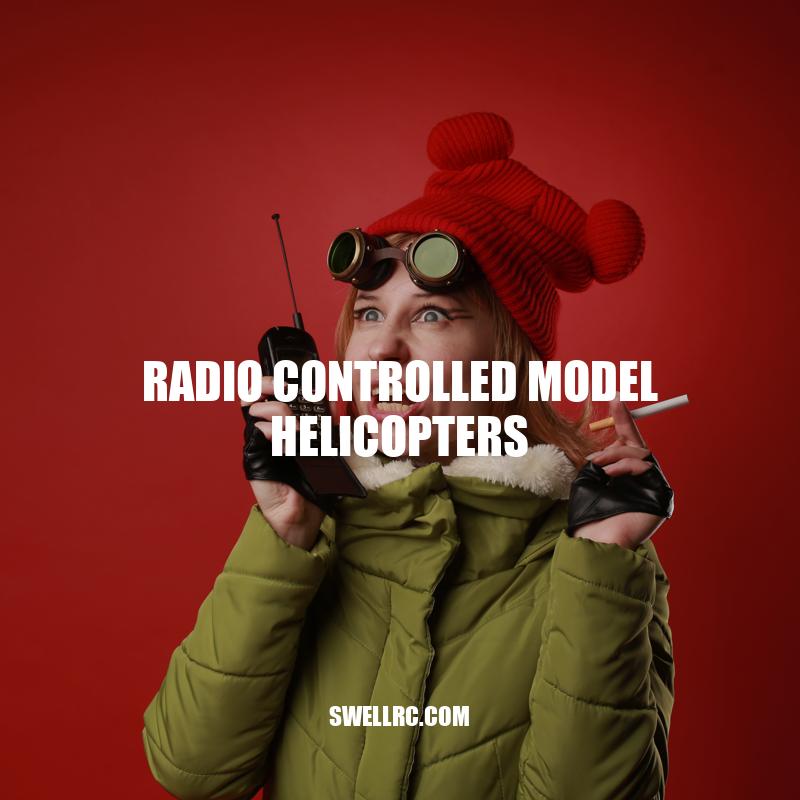Radio Controlled Model Helicopters: A Beginner’s Guide
Radio-controlled model helicopters are a fascinating piece of aviation technology. These miniature flying machines, which could be as small as a few inches or as large as several feet, are increasingly becoming popular among hobbyists worldwide. They offer enthusiasts an enjoyable and challenging experience, providing an exceptional combination of flying, engineering, and designing. However, despite their popularity, mastering the art of radio-controlled model helicopter operation can be challenging and requires continuous learning. In this article, we delve into the intricacies of controlling remote-controlled helicopters and discuss essential tips on getting started, safety and maintenance, and various models available in the market.
Radio controlled model helicopters are designed to work similarly to helicopters that are manned by pilots, except that there isn’t an actual pilot. Instead, they are controlled by a remote controller, which sends signals via radio waves to the rotor blades to move the drone around. Here is some essential information regarding the working mechanism of radio controlled model helicopters:
– The helicopter incorporates a four-channel control that decides the flying directions, namely up and down, right and left, backward and forward, and rotation around the vertical axis.
– The control system in a helicopter encompasses two main components. The transmitter, which is a handheld unit controlled by the pilot, and the receiver, which is a device installed in the helicopter, which receives the signals transmitted from the remote controller.
– The radio waves can often be controlled within a range of 20-30 meters or more.
Models of radio controlled model helicopters vary significantly in regards to their specifications and capabilities, with newer models integrating advanced technology, such as GPS, video cameras, recording devices, and obstacle avoidance mechanisms.
When flying a radio controlled model helicopter, the pilot must be responsible for operating it safely and not causing any injuries or damages. As such, before starting a flight, there are several essential steps that they must follow, including:
– Providing a thorough check of the control systems, battery, and other critical components before calibration,
– Checking the weather in the area to ensure that conditions are suitable for flying without posing any safety issues
– Identifying an appropriate and safe space to fly without interrupting or causing danger to other people or property
For more information on how radio controlled model helicopters work and how to get started in operating them, check out websites such as rcgroups.com or heliguy.com. These sites offer a wealth of information on the topic and an extensive range of models to compare and contrast.
How does a remote control helicopter work?
A remote control helicopter works by using radio signals to communicate between the transmitter and the receiver on the helicopter. The transmitter controls the helicopter’s movements by sending signals to the receiver, which then uses electric motors to change the pitch and direction of the rotor blades. The helicopter’s on-board gyroscope helps keep it stable in the air. Remote control helicopters can come in different sizes and styles for beginners and advanced users.
For more information, check out websites like RCGroups.com or check out products on Amazon.com or hobby stores like Hobby Lobby.
| Useful Websites |
|---|
| RCGroups.com |
- Beginner and advanced remote control helicopters available
- Transmitter sends signals to receiver on helicopter
- Electric motors control rotor blade pitch and direction
- On-board gyroscope helps keep helicopter stable
Beginner’s Guide to Remote-Controlled Helicopters
If you’re new to flying radio-controlled model helicopters, it might seem a bit overwhelming at first. However, with the right guidance and equipment, it is manageable. Here is an outline of the basic things you’ll need to get started:
| Remote-Controlled Helicopter Equipment | |
|---|---|
| Transmitters or controllers | A device that controls the helicopter and sends out radio waves to the drone |
| Receiver | A device installed inside the drone that receives signals transmitted by the controller |
| Battery Pack | Provides the helicopter with electric power. |
| Charger | Recharges the battery pack after the batteries’ power has been drained. |
Apart from the equipment mentioned, other essentials for new pilots include reading the user manual of the radio-controlled model helicopter equipment. The manual provides an insight into the various parameters and settings a radio control helicopter operates within, including some terms such as pitch, yaw, and roll.
When purchasing a new radio-controlled helicopter:
– Buy a model that is designed for beginners and has a simple user interface.
– Choose a helicopter that is suitable for indoor and outdoor use.
– Opt for lithium polymer (Li-Po) batteries, which are rechargeable and offer an extended flight duration compared to regular alkaline batteries.
There are many online retailers for radio-controlled helicopters, including Amazon and Horizon Hobby. These sites offer a wide range of models that come in different shapes and sizes, at various prices. Additionally, hobbyist communities such as Heliguy provide advice and support when you are starting. It’s always recommended to join a group for enthusiast hobbyists where you can ask for help from experienced pilots who might offer unmatched tips and guidance to new hobbyists.
How do you fly a helicopter remote?
Flying a remote-controlled helicopter requires some practice and patience. Here are the steps to fly a helicopter remote:
1. First, learn the controls. A helicopter remote has two joysticks – one for controlling altitude and rotation and the other for direction.
2. Start with a small or beginner model helicopter. These are easier to control and less expensive if you crash one.
3. Find an open and clear area free from trees or buildings. A park or recreational area may be an ideal place to start.
4. Begin by testing the rotors and making small adjustments to get the helicopter hovering. Use the altitude joystick to control the height of the helicopter and the rotation joystick to keep it stable.
5. Once you have mastered hovering, try to fly the helicopter forward and backward. Use the direction joystick to control the helicopter’s movement.
6. Practice makes perfect! Gradually increase the speed and complexity of your movements as you become more comfortable and confident. But always keep safety in mind.
If you are looking for a quality remote-controlled helicopter or tips on how to fly one, you can check out websites like Amazon or hobby websites like Horizon Hobby. These websites offer a wide array of remote-controlled helicopters and accessories to make your flying experience more fun and memorable.
Tips for Safely Operating your Radio Controlled Model Helicopter
While flying a radio-controlled model helicopter is a thrilling experience, it can also be hazardous if not managed safely. Here are some things to consider to ensure safe operation:
• Perform preliminary checks before taking off. Ensure that the batteries are well charged and all screws are secure.
• Choose an appropriate location for flying, with sufficient space and away from power lines, trees, and buildings.
• Be attentive while flying. Never take your eyes off the helicopter and always maintain a direct line of sight.
• Start by practicing basic maneuvers, such as lifting off, moving forwards, and hovering in one place.
• Calibrate or check the settings on the controller before flying.
• Ensure that the helicopter is flying at a safe altitude and is not interfering with other nearby helicopters.
• Fly in clear weather, avoid gusty winds and rain.
• Don’t fly near people, never fly indoors, and always respect the privacy of other individuals.
In addition to these tips, it is always advisable to seek the help of experienced hobbyists when starting. Websites such as DronePilotGroundSchool.com and RemotePilot101.com offer certifications for commercial pilots. If you’re interested in pursuing a career in flight operations or drone photography for hobby or professional purposes, such certificates can give a boost to your value and professional profile. Moreover, there are many free and paid video tutorials on websites like DJI or The Drone Girl YouTube channel that can help you build your skills with advanced techniques in flying, photography, and drone maintenance.
How to safely enter a helicopter?
Entering a helicopter safely is crucial for both passengers and crew. Here are the steps to follow:
- Wait for the pilot to signal that it is safe to approach the helicopter
- Remove any loose clothing or objects that could get caught in the rotors
- Bend down and approach the helicopter slowly from the front or the direction indicated by the pilot
- Once you are close enough, duck under the rotors and walk towards the cabin
- Grab the “oh shit” handle and step up onto the skid, facing the cabin
- As you step into the cabin, watch your head and mind any sharp edges or objects inside
- Buckle up your seatbelt and follow the crew’s instructions for the flight
It is important to stay mindful of the rotors at all times and to follow the crew’s instructions closely. Websites like www.faa.gov and products like the Aviation Safety Education’s Helicopter Safety course offer additional resources for helicopter safety.
Radio Controlled Model Helicopters are a popular hobby among aviation enthusiasts. There are various models of radio-controlled helicopters available in the market. The choice depends on the specific requirements of the operator and their budget. Here are some of the most popular models that you can check out:
• Blade 230S: It’s one of the best mid-sized helicopters with the ability to balance between performance and stability.
• Align Trex 450L: The Align Trex 450L is a high-end option that boasts cutting-edge controls and a durable build.
• WLtoys V913: A beginner-friendly helicopter that’s affordable and has a strong build.
• Syma S107G: The Syma S107G is an inexpensive model for novice enthusiasts that is adequate for indoor use.
• Blade Nano CP S: A small-sized helicopter perfect for indoor and outdoor flight that provides a high level of control.
• Syma S107G: An affordable entry-level option with a durable build that is perfect for novice pilots.
If you want to search for more models, websites like HeliFreak.com or RCgroups.com offer communities of enthusiasts where you can find reviews, build ideas, and tips for maintenance. Additionally, you can check out RC hobby shops or online stores like HobbyKing, Amazon, and Banggood for more options. It’s essential to note that the prices and the features of each model can vary greatly, therefore, do your research before you decide to buy a drone.
Which is the best remote control helicopter in the world?
There is no single answer to the question of which is the best remote control helicopter in the world. It all depends on your needs, budget, and preferences. Some popular brands and models in the market are:
- DJI Mavic 2 Pro
- Holy Stone HS100D
- Syma S107G
- Blade Nano S2
- Hubsan H107D+
Each of these remote control helicopters has its unique features, pros and cons. It is important to research and read reviews to find a helicopter that suits your requirements. If you are a beginner, it is recommended to start with an easy-to-fly, affordable model before upgrading to more advanced helicopters.
Several websites such as Amazon, Best Buy and Hobbytron offer a wide range of remote control helicopters to choose from. Make sure to compare prices, features, and customer feedback before making a purchase decision.
Conclusion
Radio-controlled model helicopters are an exciting and engaging hobby that requires dedication, patience, and time to master. Keeping in mind the requirements and experience level, there are a variety of models of remote-controlled helicopters available with varying features and capabilities. By investing time in learning and understanding the intricacies of the hobby, enthusiasts can enjoy the satisfaction of soaring above, showcasing their skill, and honing their talent. Beginner pilots can find ample resources online and in hobby stores to support and guide their endeavors. Whether it’s indoor or outdoor, flying a remote-controlled helicopter is an excellent and creative way to learn and test your aviation skills. Understanding the basic principles, taking necessary precautions, and being passionate about the hobby is the key to enjoy the thrill of flying your radio-controlled helicopter to new heights.



